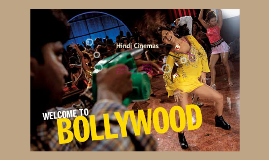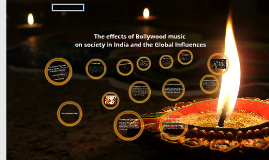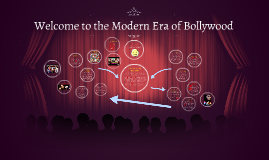Bollywood Presentation
Transcript: Three main era’s of Bollywood Studio Era (1935-1950) Considered as the establishment of playback singing in the Hindi film industry Old Bollywood (1950-1988) The era primarily dominated by freelance music directors and being influenced by the West with introducing the large orchestra system and new genres New Bollywood (1998-Present) The globalization era of Bollywood that gave music directors the technological equipment comparable to their Western counterparts and opportunity to expand their work to NRI's living abroad Technological Advancements before Studio Era Musicians became increasingly aware of the demand for their music and began adopting a more freelance approach rather than service work Freelancers traded the security of a salary for more money that could be made by working much harder Everyone adopted this freelance mantra by the late 1950s (the text describes it as everyone from a violinist in an orchestra to Lata Mangeshkar) Different Eras of Bollywood Relevance of Bollywood to India Hum Aapke Hain Kaun -“Filmigit” is a term which refers to the music or songs of popular South Asian movies . Almost all music in the Indian subcontinent are filmigit and incorporate music styles from around the world, giving it a transnational structure and feeling. This is why Bollywood music not only contributes to Indian modernity but also to the global culture. Studio Era With the rise of technology, the industry was changing rapidly. It took the industry and those involved some time to react to the implications of that change. The size of orchestras was seen as a sign of prestige, and the old studios that were relatively large were finally perceived as unnecessary expenses. The stronger and more immediate impact of the globally dominant Hollywood culture may also have contributed to these changes - Film studios in Kolkata may have had an early lead in the production and distribution of films (as Madan Theatres did) or in the technology of playback (New Theatres), but Kolkata’s studios and films were outnumbered by Mumbai’s increasing dominance of Hindi film production and its high output of films in general. - Hindi films and their music, explicitly hybrid forms, were viewed quite negatively by early Indian governments, who taxes both producers and consumers excessively. - During and after ww2, Mumbai was awash in money earned illegally by profiteers who had benefited from the wartime show time. This was not legal money that could be officially declared or openly invested- except in film where no concrete proof of the amount invested its required” - The emerging “star system” contributed to the decline of the producing studios. In the 30’s and 40’s salaried employment was the norm. Actors, composer, and most of them went to work every day “whether there was work or no work, land prices, high taxes, increasing star fees, and the presence of illegal money may well have been the primary causes of collapse of the producing studios. Popular Indian music entered the modern era during the early years of the twentieth century with the arrival of gramophone technology. Some of the motivations behind the early recordings would include spreading awareness, on the part of colonial entrepreneurs, that the market for Indian recorded music was predicted to be highly profitable. John Watson Hawd, whom was the agent for the Gramophone and Typewriter Company’s agent in Calcutta, often wrote to his superiors in London on the advantages that would be present if they were to enter the recording business in India. Contemporary Indian music consists of three genres which are: Bollywood, Classical and Folk. Classical music can be traced back to Amir Khusrau who supposedly invented the sitar and to an earlier era of temple singing. Classical music has been institutionalized through “gharana’s” which refers to a family of musicians or a school of music. Gharana’s were supported by the rulers of princely states and lead to classical music becoming a part of a higher culture Folk music may be too connected to its origins and may not properly function as a form of popular art Examples of this include folk songs that are sung by only a certain gender or a by people belonging to a certain caste. EXAMPLE: Disco Dancer (1981), violins were a bit down and used mostly for effects. but lots of instruments were still there. Members of our Group Decline of Studio Era Contemporary Indian Music Raj Johal Sameer Pannu Navdeep Chahal Malika Grewal Jaskaran Grewal Haysham Zia Daniyal Irfan Sarah A Bappi Lahiri is a respected music director in India and is credited for popularizing synthesized disco music into filmigit. Synthesized disco music brought together the sounds of the east and west as well as fused popular music with classical music. Unfortunately, it is known that Bappi Lahiri has plagiarized many of songs, for example: Bappi Lahiri has not denied the fact that he has stolensongs, but claims that he is not alone for it has become a trend.

















